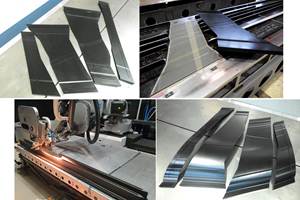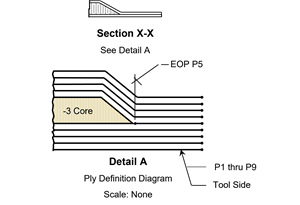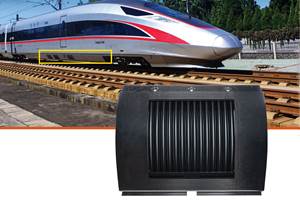The global electrification of transportation is an uneven evolution, simultaneously enabled and hindered by the myriad forces that govern technology development and affect everything from automobiles and unmanned aircraft to rail transport and marine craft. These enabling/hindering forces include fast-maturing but heavy batteries, government oversight that is sometimes slow to adapt, principles of gravity and friction, strict passenger safety requirements, anxious insurers and uneven development of lightweight materials.
Still, materials, processing, hardware and software innovations are making possible products that just a few years ago were inconceivable, and there may be no better example of this than the Seven, a new all-electric, high-range, all-composite foiling speedboat being manufactured by Candela Boats (Lidingö, Sweden) using resin matrix solutions provided by Sicomin Epoxy Systems (Châteauneuf les Martigues, France).
How we got here
Candela Boats was founded in 2014 by CEO Gustav Hasselskog who, although an engineer by education, had worked previously as a consultant and in the consumer chemicals market. By his own admission, Hasselskog “had become bored” with the corporate work world and decided that he wanted to find more meaningful work. He quit his corporate job in 2014 and during that summer retreated with his family to a home located on one of the archipelagos that surround Stockholm, Sweden.
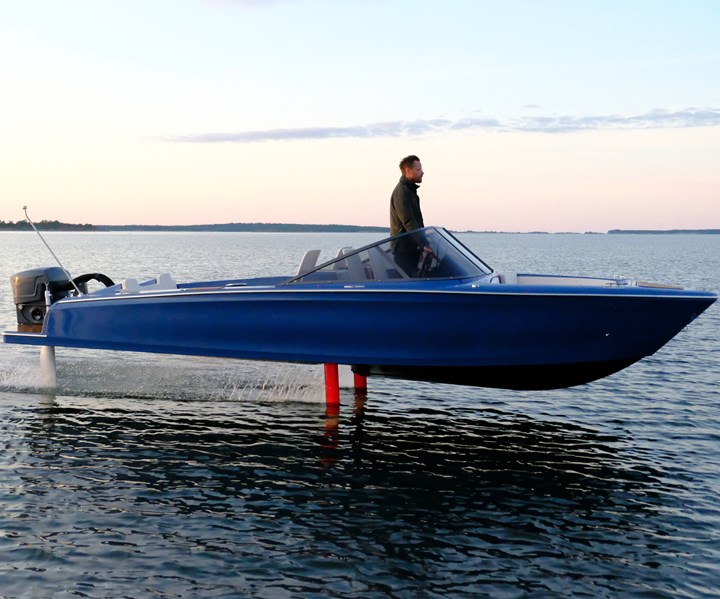
Candela Boats CEO Gustav Hasselskog drives the Seven in foiling mode. The all-electric boat cruises at 22 knots, has a top speed of 30 knots and a range of 50 nautical miles. Hasselskog was looking to develop a boat that offers the maneuverability of a planing boat while taking full advantage of an electric propulsion system. The Seven is 15 times more efficient than a comparable gas-powered planing boat. Source | Candela Boats
“We had a 25-foot boat with a V-8 engine,” Hasselskog recalls, adding that going anywhere and getting anything required a boat trip to Stockholm, which cost at least $50 per trip. “It felt a bit weird, to be spending so much money on a boat,” he says. Hasselskog started doing some math, wondering what it would take to make recreational boating more efficient. “What I discovered,” he says, “is that the topic has not been addressed to make boats more efficient and make them electric.”
Hasselskog began studying the recreational marine market further. He studied battery and electric propulsion technology, determining what would be required to give a planing boat a range of at least 50 nautical miles — a goal he thought reasonable. Until now, application of all-electric propulsion in planing watercraft has been plagued by lack of power and lack of range, primarily because of the water surface friction a boat must overcome. Further, to increase range or power in a planing boat requires the addition of batteries, which also adds weight and, by extension, drag. In short, Hasselskog discovered, it wasn’t possible to make a planing boat more efficient. “A planing boat is a dead end. You can’t make it more efficient,” he says. “Foiling is the only way.” So, Hasselskog sold the family’s summer home on the archipelago, and in 2014 Candela Boats was born.
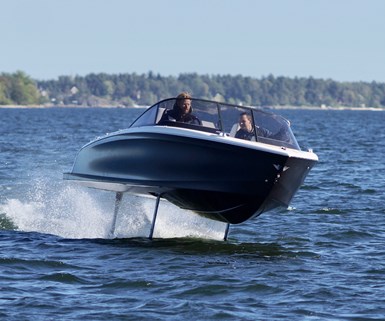
Foiling is inherently unstable because of the complex thermodynamics involved. Candela Boats developed a sophisticated system of sensors and controls to manipulate the foils and ensure a smooth, safe ride. Source | Candela Boats
Foiling is not for the faint of heart
The primary challenge of foiling lies in the inherent instability of a boat moving through and over water, but not on the surface of the water. A foil — or, more accurately, a hydrofoil — is a wing-like structure attached to the bottom of a boat hull. The foil passes through the water perpendicular to the direction of travel and, using the same principles of aircraft flight, at a certain speed provides enough lift to elevate the boat completely clear of the water. Hull friction is thus eliminated, leaving foil drag and air as the only resistors.
Foils can take a variety of shapes, but in all cases they must provide a flat planar surface that passes through the water edge-first. And, like an aircraft wing, a foil’s angle of attack in the water can be adjusted to increase or decrease lift. Foils also can be deployed at a variety of water depths, but the depth has an effect on the efficiency. For example, relatively shallow, surface-piercing foiling is more stable, but less efficient. Deeper foiling is more efficient but less stable.
In any case, “flying” over water presents a very different hydrodynamic environment compared to that faced by a planing boat on the water’s surface. Out of the water and riding on foils, a boat behaves very differently — weight distribution, turning, wind resistance and turbulent waters must be carefully managed.
Foiling technology, although more than 100 years old, until now has been used primarily in large racing yachts and some passenger ferries. Foiling racing yachts are typically manned by large crews well-trained to manage a dynamic, fast-moving foiling structure. Foiling ferries rely on surface-piercing foiling, which, as noted, is more stable.
Hasselskog decided to make his speedboat as efficient as possible and so opted for deep foils. The challenge would be to make a deep-foiling boat operate easily, seamlessly and safely, regardless of who is at the wheel. Doing so would require development of an unprecedented foiling control system, and a boat structure that is not only lightweight, but designed specifically for foiling.
Building the perfect foil
The Seven is 7.7 meters long, 2.4 meters wide, weighs 1,300 kilograms and has a capacity of six people. It uses two foils, the largest of which is deployed about 2 meters from the front of the boat. The design of the primary foil is relatively simple: Two struts pass through the hull into the water and attach at right angles to a foil that is 2.35 meters long, 200 millimeters wide and 25 millimeters thick. The foil — also called an inverted ∏-foil — is oriented perpendicular to the direction of travel. The foil struts are motor-actuated to move up and down to lower and raise the foil. When the boat is not foiling, the foil is fully retracted flush with the boat hull. At foiling speeds, the foil is deployed into the water to a maximum depth of 550 millimeters.
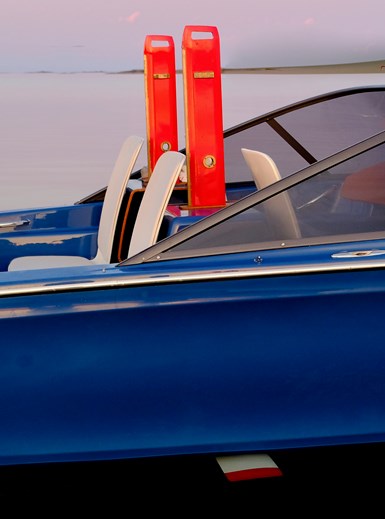
When the Seven is not in foiling mode, the two orange struts that connect to and actuate the foil to pull it flush to the hull. The white and orange foil is visible here just below the hull and just above water level. Source | Candela Boats
At the rear of the boat is a second, smaller T foil that also acts as the rudder. It is attached to a 55-kilowatt electric motor that actuates a driveshaft in the rudder that turns a propeller at the end of the rudder. The motor is powered by rechargeable batteries, located in the very forward section of the hull, to provide balance when the boat is foiling. The Seven begins foiling at 14-15 knots, cruises at 22 knots, has a maximum speed of 30 knots and a range of 50 nautical miles.
Teodor Hällestrand, product manager at Candela Boats, says the foil struts and foils are carbon fiber/epoxy composites and posed a significant design engineering challenge. To provide the control required for a smooth ride, Candela needed to be able to adjust the foil to changing boat conditions. This requires a highly dynamic sensor/control system paired with a highly responsive foil. “The foil is straight, but we wanted to be able to twist it in the water, depending on speed, roll angle, pitch angle and yaw angle,” Hällestrand says. “We can understand how the boat is positioned and then adjust for orientation to make the ride as smooth as possible.” This is accomplished by the control system, which dynamically adjusts the struts to either change the angle of attack of the foil or to twist the foil, particularly for turning.
Hasselskog says, “We need to be able to twist the front foil or provide a different angle of attack.” All of these actions happen under load, he says, “so we need a material with low torsional stiffness, but with high bending stiffness.” The result is a “fairly elaborate layup plan” that uses unidirectional (UD) carbon fiber tapes (mainly ±45 degrees) to provide the stiffness and bending capabilities required. The foil uses standard modulus carbon fiber from a variety of suppliers and infused with SR1710 epoxy resin supplied by Sicomin Epoxy Systems. The foil is room-temperature cured, followed by a 40°C post-cure.
Not your average hull
Nowhere is Seven’s departure from planing boat design standards more apparent than in the hull — both in design and engineering. Most noticeable is the fact that although it features a standard V-shaped, wave-breaking hull at the front of the boat, the hull is flat from the front foils to the aft. Hasselskog points to several reasons for this.
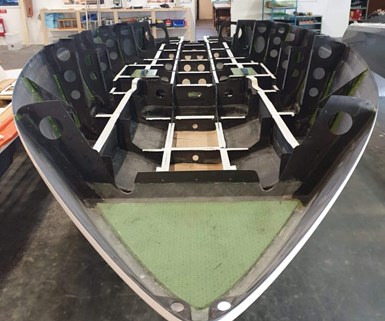
The interior of Seven’s hull shows the stringers and ribs that are cut from carbon fiber/epoxy composite laminates and then bonded into place with adhesive and mechanical fasteners. This architecture allows Candela Boats to quickly assemble hulls, and provides flexibility to adapt to design changes. Source | Candela Boats
First, he says, we “only need the V shape to pierce the waves.” It also protects the foils when the boat is not foiling. Second, flattening half the hull simplifies manufacturing and saves much weight. Third, he says, the flat bottom makes the boat incredibly stable at the dock for embarking/disembarking. “It’s like a barge,” he notes.
Inside the hull, however, is where Candela has worked to make the Seven not only structurally sound, but adaptable to efficient, relatively high-rate manufacturing. Hällestrand says the hull is comparable in design to an aircraft fuselage — a skin surrounding a lattice of stringers and ribs. Like the foil, the hull is infused, using the same UD carbon fiber and SR1710 epoxy, fabricated on composite tooling also made with SR1710. Hull thickness below the waterline is 3 millimeters; hull thickness above the waterline is 2 millimeters.
Marc Denjean, export manager at Sicomin, says the SR1710 is a performance epoxy system that provides “way above average mechanical properties.” Sicomin also provides an in-mold epoxy high-build primer, which means the hull is demolded ready for painting.
To build the stringers and ribs, Candela starts with 3-millimeter-thick solid laminate carbon fiber/epoxy infused panels and then CNC machines them to shape, depending on where in the hull the laminate is being placed. To build the hull structure — stringers and ribs — these cut shapes are then assembled and attached to each other and the hull with adhesive bonding and mechanical fasteners.

The battery pack of the Seven is located in the forward section of the hull, to provide much-needed balance when the boat is in foiling mode.
Source | Candela Boats
This laminate cut-and-assemble design/manufacturing process, says Hasselskog, has proved highly efficient and allows Candela Boats to build the hull structure in just 40 hours. It also allows the company to easily adjust internal structures to design changes without the expense and time required to modify molds. “It’s easy to scale up, make changes or build new structure just by changing machining code,” he says.
The bottom line
In keeping with Hasselskog’s original vision, the efficiency of the Seven is difficult to beat — it is 4-5 times more energy-efficient than a comparable gas-powered planing boat and converts 90% of its chemical energy to mechanical energy. Further, the cost of ownership of the Seven, according to Candela, is 95% less than a gas-powered planing boat.
The company has 190 orders for the Seven, and it expects to assemble 40 boats in 2020. Hasselskog says that currently Candela is a boat designer and assembler only. Fabrication of composite structures is being done by third parties, but Hasselskog says Candela may bring that work in-house as it seeks to optimize manufacturing processes and, ultimately, reduce the company’s carbon footprint. “We have to get our costs down, and that means manufacturing more efficiently,” Hasselskog says. “We’re not there yet, but we are headed in the right direction.”
Related Content
3D-printed CFRP tools for serial production of composite landing flaps
GKN Aerospace Munich and CEAD develop printed tooling with short and continuous fiber that reduces cost and increases sustainability for composites production.
Read MoreThe basics of composite drawing interpretation
Knowing the fundamentals for reading drawings — including master ply tables, ply definition diagrams and more — lays a foundation for proper composite design evaluation.
Read MoreComposite sidewall cover expands options for fire-safe rail components
R&D project by CG Rail explores use of carbon fiber-reinforced thermoplastics and recycled manufacturing scrap to meet fire safety, weight and volume targets.
Read MoreBladder-assisted compression molding derivative produces complex, autoclave-quality automotive parts
HP Composites’ AirPower technology enables high-rate CFRP roof production with 50% energy savings for the Maserati MC20.
Read MoreRead Next
Developing bonded composite repair for ships, offshore units
Bureau Veritas and industry partners issue guidelines and pave the way for certification via StrengthBond Offshore project.
Read More“Structured air” TPS safeguards composite structures
Powered by an 85% air/15% pure polyimide aerogel, Blueshift’s novel material system protects structures during transient thermal events from -200°C to beyond 2400°C for rockets, battery boxes and more.
Read MorePlant tour: Daher Shap’in TechCenter and composites production plant, Saint-Aignan-de-Grandlieu, France
Co-located R&D and production advance OOA thermosets, thermoplastics, welding, recycling and digital technologies for faster processing and certification of lighter, more sustainable composites.
Read More
















